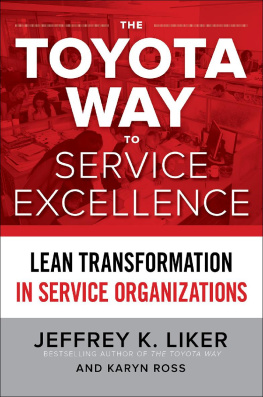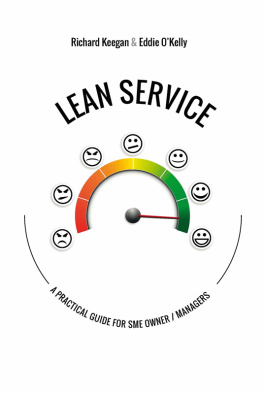INTRODUCTION
The CEO of a midsized retail chainwas excited. He'd just been to an Executive Roundtable on Lean Six Sigma and thought it sounded like the answer to his prayers. His company was suffering from a steady drop in saleshe'd already had three bad quarters in a row and couldn't afford many more. He was a little skeptical of claims that other companies were seeing net benefits of $500,000 or more of increased operating profit per Black Belt, but even half that would be significant to a company like his.
After a little more research, the CEO called together the senior management team and spoke enthusiastically of Lean Six Sigma and how it could help their organization bridge the gap between their current promises to the "street" and what they could reasonably expect to deliver. He appointed the VP of operations to be in charge of getting Lean Six Sigma up and running. He was most emphatic about the need to see results within the fiscal year and sooner if possible, telling the VP, "Judging from what I hear we should only need a dozen Black Belts out there and we'll make our fiscal targets. This is your baby. Just give me monthly updates."
If you had to guess, what odds would you give for this company ending up as a stellar example of Lean Six Sigma deployment?
Lean Six Sigma's supporters emphasize how much more effective it is than predecessors such as continuous improvement and TQM: better tied to customer priorities, easier to track throughout the company, much more linked to business strategies. And we all know the companieslike Bank of America, GE Capital, Starwood, ITTwho have used Six Sigma to drive customer satisfaction, improve quality, and generate impressive financial payback. Yet for each of these success stories there are many other companies like the one above who stand to achieve only a fraction of the full Lean Six Sigma potential.
The question is what makes the difference between the successful deployments and those that end up as a program-du-jour, an initiative forgotten or ignored at executive levels, living on only in the work of a few passionate, frustrated zealots?
An article in Fortune from June 21, 1999, called "Why CEOs Fail," provides a crucial clue. Authors Ram Charan and Geoffrey Colvin comment, "In the majority of caseswe estimate 70%the real problem isn't the high-concept boners the boffins love to talk about It's bad execution."
For anyone struggling with the execution of strategy, Charan and Colvin's article is a wake-up call. For years, the experts have told us that the most critical leadership skill was mobilizing the troops around a clear vision and winning strategy. A leader's job was to clearly communicate where she or he wanted to go, then trust employees to find a way to get there.
As Charan and Colvin point out, it's becoming increasingly clear that we need to put as much or more emphasis on implementation. And they are far from alone in their belief. Pushing that idea even deeper, consultant Tom Curren described a two-year research effort by McKinsey and Company that identified nine mistakes responsible for 80% of the failures of significant change efforts.
1. No performance focus
2. Lack of winning strategy
3. Failure to make a compelling and urgent case for change
4. Not distinguishing between decision-driven and behavior-dependent change
5. Failure to mobilize and engage pivotal groups
6. Over-reliance on structure and systems to change behavior
7. Lack of skills and resources
8. Leaders' inability or unwillingness to confront how they and their roles must change
9. Inability to integrate and align all the initiatives
Notice that having the right strategy is only one of these factors; the remaining eight relate to implementation: either poor execution or a lack of attention paid to interactional issues (engaging people in shaping and supporting the deployment).
For an organization considering (or already involved in) Lean Six Sigma, this means the biggest challenges will most likely arise in
Execution barriers
Attaining CEO and P&L management engagement
Resource dedication: Achieving 1% (or more) of employees as full-time Black Belts assigned to continuous improvement efforts
Project selection: Choosing improvement projects based on strategic goals/needs prioritized to increased value (ROIC)
Developing "Lean" eyes: Recognizing the need to eliminate process waste and delays (in terms of work and/or costs)not just improve qualityto achieve their operational goals
Data-driven management: Using process knowledge and data to make decisions
Interactional issues
Creating alignment and understanding of strategy, especially among those who wield the most influence (formal or informal) within the organization and those who execute projects
Fostering a collaborative mentalitybetween coaches and teams, between departments, between managersas a means for leveraging efforts
The companies profiled in of this book come from very different sectors and face very different competitive pressures. They don't all use the term "Lean Six Sigma" to describe what they're doing (though it forms the substance of their improvement efforts), nor have they chosen identical pathways through execution and interaction. But the fundamental consistencies in their approach far outweigh the superficial differences. At the most basic level, they are all working to avoid the implementation barriers by integrating Lean Six Sigma into the everyday business of running and improving the organization.
To achieve such integration in your own organization, it helps to think of deployment as occurring in four phases:
1. Readiness: Identifying all the factors that should be considered when structuring how Lean Six Sigma will be used to more effectively execute your organization's strategy (such as your organization's ability to implement major change)
2. Engagement: Getting people excited about (and asking for) Lean Six Sigma by demonstrating its role in helping them achieve their annual and quarterly goals
3. Mobilization: Establishing the infrastructure and getting other elements in place for deployment
4. Performance and Control: Implementing deployment plans, establishing control measures and processes to ensure that Lean Six Sigma improvements endure and that efforts remain closely aligned with business strategies
For the purposes of this book, we've devoted separate chapters to each of these phases. But it's important to realize that these stages overlap: The way in which you do a readiness assessment will influence whether people want to become engaged in the effort; work on building engagement will continue long after you've begun erecting the formal infrastructure and launching projects; control measures will be layered over ongoing performance activities.
In reality, the separation between phases will not be as neat as that described in the following chapters. Many of the lessons you'll see in these chapters are summarized in a master list of success factors in (p. 255). But keep in mind that what is appropriate at one company may not be for yours, so any interpretation of the guidelines should be tempered by your own judgment and experience about what works in your environment.
Endnotes
are based on real companies and people, but some identities of some companies and their employees have been disguised to protect confidentiality.
2. See www.topteamalignment.com/whyfail.html
CHAPTER 5
The Value in Conquering Complexity
It all started innocently enough. About four years ago, a few of Bank One's Wholesale Lockbox customers asked if they could use overnight delivery and get their depositssometimes as much as $1 millioncredited quickly the following day. Bank One naturally said "No problem. We'll give you a four-hour turnaround time. And there won't be any charge for the service."















